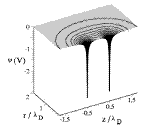Electrical and Computer Engineering, Department of

P. F. (Paul Frazer) Williams Publications
Document Type
Article
Date of this Version
10-2008
Abstract
Apple juice inoculated with Escherichia coli ATCC 23472 was processed continuously using either ultraviolet (UV), high-voltage pulsed electric field (PEF), or a combination of the PEF and UV treatment systems. Apple juice was pumped through either of the systems at 3 flow rates (8, 14, and 20 mL/min). E. coli was reduced by 3.46 log CFU/mL when exposed in a 50 cm length of UV treatment chamber at 8 mL/min (2.94 s treatment time with a product temperature increase of 13 °C). E. coli inactivation of 4.87 log CFU/mL was achieved with a peak electric field strength of 60 kV/cm and 11.3 pulses (average pulse width of 3.5 μs, product temperature increased to 52 °C). E. coli reductions resulting from a combination treatment of UV and PEF applied sequentially were evaluated. A maximum E. coli reduction of 5.35 log CFU/mL was achieved using PEF (electrical field strength of 60 kV/cm, specific energy of 162 J/mL, and 11.3 pulses) and UV treatments (length of 50 cm, treatment time of 2.94 s, and flow rate of 8 mL/min). An additive effect was observed for the combination treatments (PEF and UV), regardless of the order of treatment (P > 0.05). E. coli reductions of 5.35 and 5.30 log CFU/mL with PEF treatment (electrical field strength of 60 kV/cm, specific energy of 162 J/mL, and 11.3 pulses) followed by UV (length of 30 cm, treatment time of 1.8 s, and flow rate of 8 mL/min) and UV treatment followed by PEF (same treatment conditions), respectively. No synergistic effect was observed.


Comments
Published in Journal of Food Science 73:9 (2008), pp. M412-M417; doi 10.1111/j.1750-3841.2008.00956.x Copyright © 2008 Institute of Food Technologists; published by John Wiley & Sons, Inc. Used by permission. http://www3.interscience.wiley.com/journal/118509799/home